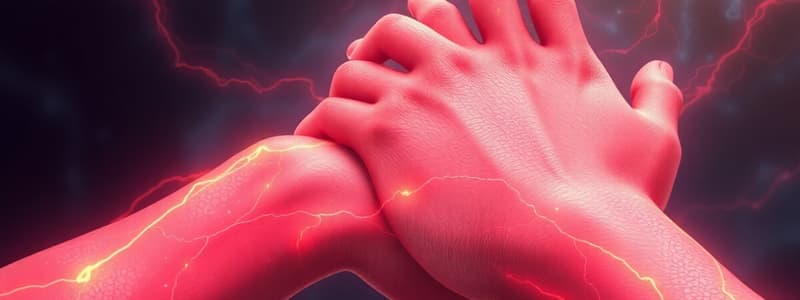Podcast
Questions and Answers
What is the primary factor contributing to intertrigo?
What is the primary factor contributing to intertrigo?
- Infection by Staph aureus
- Excessive skin moisture (correct)
- Beta-lactamase resistance
- Overgrowth of Candida albicans
Which characteristic symptoms are commonly associated with cellulitis?
Which characteristic symptoms are commonly associated with cellulitis?
- Intense pruritus and a scaly rash
- Dry, flaky skin and eczema
- Erythema, edema, warmth, and tenderness (correct)
- Flu-like symptoms without any visible lesions
What type of antibiotics should be used to treat cellulitis?
What type of antibiotics should be used to treat cellulitis?
- Broad-spectrum antibiotics only
- Beta-lactamase resistant antibiotics (correct)
- Topical antifungals
- Narrow-spectrum antibiotics
In which areas of the body is intertrigo most commonly found?
In which areas of the body is intertrigo most commonly found?
What is a classic sign of scabies?
What is a classic sign of scabies?
What is the most important aspect of treating intertrigo?
What is the most important aspect of treating intertrigo?
Which population is most likely to develop scabies?
Which population is most likely to develop scabies?
What laboratory test is recommended before starting treatment for cellulitis?
What laboratory test is recommended before starting treatment for cellulitis?
What is the primary purpose of ligating an incompetent vessel?
What is the primary purpose of ligating an incompetent vessel?
What is a common treatment for ulcers as noted in the content?
What is a common treatment for ulcers as noted in the content?
What skin condition is typically associated with chronic lymphedema?
What skin condition is typically associated with chronic lymphedema?
What is an appropriate management strategy for chronic lymphedema?
What is an appropriate management strategy for chronic lymphedema?
What should be avoided when using Unna boots for ulcer treatment?
What should be avoided when using Unna boots for ulcer treatment?
What is the primary long-term concern for a limb with chronic lymphedema?
What is the primary long-term concern for a limb with chronic lymphedema?
How does chronic lymphedema initially develop?
How does chronic lymphedema initially develop?
What is a function of sequential compression devices (SCDs) in lymphedema treatment?
What is a function of sequential compression devices (SCDs) in lymphedema treatment?
What is a characteristic feature of crusted scabies?
What is a characteristic feature of crusted scabies?
What is the primary cause of itching and rash in scabies?
What is the primary cause of itching and rash in scabies?
What is the first line treatment for standard scabies?
What is the first line treatment for standard scabies?
Which statement about Zoster is correct?
Which statement about Zoster is correct?
What is the recommended action if the V1 dermatome is involved in Zoster?
What is the recommended action if the V1 dermatome is involved in Zoster?
What is a common complication of Zoster after the eruption resolves?
What is a common complication of Zoster after the eruption resolves?
What is the dosage regimen for oral ivermectin in severe scabies cases?
What is the dosage regimen for oral ivermectin in severe scabies cases?
How long can itching and rash persist after successful treatment of scabies?
How long can itching and rash persist after successful treatment of scabies?
What is the primary treatment for zoster to reduce the risk of post-herpetic neuralgia?
What is the primary treatment for zoster to reduce the risk of post-herpetic neuralgia?
Which age group shows the highest likelihood of developing post-herpetic neuralgia?
Which age group shows the highest likelihood of developing post-herpetic neuralgia?
In which stage of Cutaneous T-Cell Lymphoma (CTCL) are malignant T-cells found in the blood and lymph nodes?
In which stage of Cutaneous T-Cell Lymphoma (CTCL) are malignant T-cells found in the blood and lymph nodes?
What characterizes the blisters associated with Bullous Pemphigoid?
What characterizes the blisters associated with Bullous Pemphigoid?
What type of malignancy is Cutaneous T-Cell Lymphoma (CTCL) primarily associated with?
What type of malignancy is Cutaneous T-Cell Lymphoma (CTCL) primarily associated with?
What is a common initial presentation of Mycosis Fungoides?
What is a common initial presentation of Mycosis Fungoides?
Which treatment is typically used for patch-stage CTCL?
Which treatment is typically used for patch-stage CTCL?
What triggers the autoimmune response in Bullous Pemphigoid?
What triggers the autoimmune response in Bullous Pemphigoid?
What are the common symptoms associated with stasis dermatitis?
What are the common symptoms associated with stasis dermatitis?
What is the primary cause of stasis dermatitis?
What is the primary cause of stasis dermatitis?
How does stasis dermatitis typically progress if left untreated?
How does stasis dermatitis typically progress if left untreated?
Where are ulcers most likely to develop in cases of severe stasis dermatitis?
Where are ulcers most likely to develop in cases of severe stasis dermatitis?
What characterizes the Id reaction associated with severely inflammatory stasis dermatitis?
What characterizes the Id reaction associated with severely inflammatory stasis dermatitis?
Which factor is NOT a possible cause of impaired blood flow leading to venous hypertension?
Which factor is NOT a possible cause of impaired blood flow leading to venous hypertension?
What is the first step in managing stasis dermatitis?
What is the first step in managing stasis dermatitis?
In which patient demographic is stasis dermatitis most common?
In which patient demographic is stasis dermatitis most common?
What condition should a patient with bilateral, red, swollen, painful calves be treated for, in the absence of fever and malaise?
What condition should a patient with bilateral, red, swollen, painful calves be treated for, in the absence of fever and malaise?
What is the primary treatment for stasis dermatitis?
What is the primary treatment for stasis dermatitis?
Why should vascular studies be conducted in patients with sudden onset stasis dermatitis?
Why should vascular studies be conducted in patients with sudden onset stasis dermatitis?
How do graduated compression stockings specifically aid in treating stasis dermatitis?
How do graduated compression stockings specifically aid in treating stasis dermatitis?
What topical treatment is most commonly used for reducing inflammation in stasis dermatitis?
What topical treatment is most commonly used for reducing inflammation in stasis dermatitis?
Why should patients with chronic stasis dermatitis avoid using many topicals?
Why should patients with chronic stasis dermatitis avoid using many topicals?
What should be done if arterial insufficiency is suspected before applying compression?
What should be done if arterial insufficiency is suspected before applying compression?
What is the appropriate course of action for patients with difficult-to-heal ulcers related to stasis dermatitis?
What is the appropriate course of action for patients with difficult-to-heal ulcers related to stasis dermatitis?
Flashcards
Stasis Dermatitis
Stasis Dermatitis
A skin condition primarily affecting the lower legs, caused by poor blood flow back to the heart.
Venous Hypertension
Venous Hypertension
Increased pressure within the veins, often due to impaired blood flow out of the legs.
Id Reaction
Id Reaction
A generalized, pruritic eruption of small, pink papules and vesicles that can occur with severe stasis dermatitis.
Erythema
Erythema
Signup and view all the flashcards
Scaling
Scaling
Signup and view all the flashcards
Extravasation
Extravasation
Signup and view all the flashcards
Proteases and Lysosomes
Proteases and Lysosomes
Signup and view all the flashcards
Diagnosis
Diagnosis
Signup and view all the flashcards
Cellulitis
Cellulitis
Signup and view all the flashcards
Leg Compression Therapy
Leg Compression Therapy
Signup and view all the flashcards
Graduated Compression Stockings
Graduated Compression Stockings
Signup and view all the flashcards
Allergic Contact Dermatitis
Allergic Contact Dermatitis
Signup and view all the flashcards
Triamcinolone 0.1% Ointment
Triamcinolone 0.1% Ointment
Signup and view all the flashcards
Doppler Studies
Doppler Studies
Signup and view all the flashcards
Deep Vein Thrombosis (DVT)
Deep Vein Thrombosis (DVT)
Signup and view all the flashcards
Chronic Lymphedema
Chronic Lymphedema
Signup and view all the flashcards
Chronic Lymphedema: Skin Appearance
Chronic Lymphedema: Skin Appearance
Signup and view all the flashcards
Compression Garments for Lymphedema
Compression Garments for Lymphedema
Signup and view all the flashcards
Sequential Compression Devices (SCDs)
Sequential Compression Devices (SCDs)
Signup and view all the flashcards
Chronic Lymphedema: Inflammation and Fibrosis
Chronic Lymphedema: Inflammation and Fibrosis
Signup and view all the flashcards
Chronic Lymphedema: Cause
Chronic Lymphedema: Cause
Signup and view all the flashcards
Chronic Lymphedema: Complications
Chronic Lymphedema: Complications
Signup and view all the flashcards
Chronic Lymphedema: Weight Management
Chronic Lymphedema: Weight Management
Signup and view all the flashcards
Intertrigo
Intertrigo
Signup and view all the flashcards
Silver sulfadiazine cream
Silver sulfadiazine cream
Signup and view all the flashcards
Beta-lactamase resistant antibiotics
Beta-lactamase resistant antibiotics
Signup and view all the flashcards
Elevated WBC count
Elevated WBC count
Signup and view all the flashcards
Nystatin
Nystatin
Signup and view all the flashcards
Topical azoles
Topical azoles
Signup and view all the flashcards
Crusted Scabies
Crusted Scabies
Signup and view all the flashcards
How to treat scabies
How to treat scabies
Signup and view all the flashcards
Shingles (Herpes Zoster)
Shingles (Herpes Zoster)
Signup and view all the flashcards
Dermatomal Distribution
Dermatomal Distribution
Signup and view all the flashcards
Ophthalmic Zoster
Ophthalmic Zoster
Signup and view all the flashcards
Post-Herpetic Neuralgia
Post-Herpetic Neuralgia
Signup and view all the flashcards
Postherpetic neuralgia
Postherpetic neuralgia
Signup and view all the flashcards
Mycosis Fungoides/Cutaneous T-Cell Lymphoma (CTCL)
Mycosis Fungoides/Cutaneous T-Cell Lymphoma (CTCL)
Signup and view all the flashcards
Bullous Pemphigoid (BP)
Bullous Pemphigoid (BP)
Signup and view all the flashcards
Disseminated Zoster
Disseminated Zoster
Signup and view all the flashcards
Antiviral Treatment for Shingles
Antiviral Treatment for Shingles
Signup and view all the flashcards
Treatment for Post-herpetic Neuralgia
Treatment for Post-herpetic Neuralgia
Signup and view all the flashcards
Zoster Vaccine
Zoster Vaccine
Signup and view all the flashcards
Study Notes
Stasis Dermatitis/Id Reactions
- Stasis dermatitis is common in older adults and those with leg trauma/surgery.
- Affects lower legs, often associated with leg edema.
- Initial symptoms include redness, warmth, and tenderness.
- Progresses to scaling and weeping.
- Long-term can cause brown discoloration.
- Severe cases develop ulcers, typically proximal to the medial malleolus, which are moist and exude fluid.
- Inflammatory stasis dermatitis can manifest as a generalized pruritic eruption (Id reaction).
- Venous hypertension (impaired blood flow from legs), due to various factors (thrombosis, valves, obesity) is the primary issue.
- Venous hypertension leads to fluid, protein, white blood cells, and red-blood-cells extravasation.
- Extravasated substances cause inflammation and tissue damage.
- Diagnosis is crucial; bilateral, red, swollen, painful calves without fever or high WBC counts suggest stasis dermatitis, not cellulitis.
- Treatment involves topical steroids, leg elevation, and compression (graduated compression stockings).
- Topical triamcinolone 0.1% ointment is preferred to minimize contact dermatitis risk.
- Systemic steroids are sometimes necessary for severe cases (Id reactions).
Vascular Studies
- Usually not needed unless stasis dermatitis develops suddenly.
- Doppler studies should rule out deep vein thrombosis (DVT).
Compression Stockings
- Graduated compression stockings are common treatment, with highest compression at the ankle.
- Promotes fluid movement upwards, which is beneficial before arterial compromise is confirmed.
Topical Steroids
- Applied twice daily to reduce inflammation.
- Triamcinolone 0.1% ointment is often the preferred topical steroid.
- Consider risk of contact dermatitis in patients receiving topical treatment, as the affected limb can become sensitive to other creams and oils.
Ulcer Treatment
- Aggressive compression is important; Unna boots are a useful inexpensive option.
- Topical steroids are usually effective
- Avoid use in infected ulcers.
Chronic Lymphedema
- Often follows chronic stasis dermatitis.
- Characterized by thick, hardened skin.
- Risk of infection, ulcerations, pain, and impairment from persistent buildup of lymph fluid in affected area.
- Treatment aims to prevent progression, infection, and ulceration with compression garments, sequential compression devices (SCDs), and addressing any contributing factors (obesity).
Cellulitis
- Common bacterial skin infection, presenting with erythema and tenderness; often accompanied by edema, malaise and elevated WBC counts.
- Typically caused by Staphylococcus aureus or Streptococcus pyogenes.
- Blood cultures should be checked before antibiotics are started.
- Should be treated with antibiotics resistant to beta-lactamases
Intertrigo
- Common in older, overweight individuals, occurring in skin folds.
- Characterized by moist, erythematous skin, often in areas where skin touches skin.
- Usually caused by excessive moisture and yeast overgrowth (Candida albicans)
Scabies
- Common skin infestation, mainly causing intense pruritus (itching).
- Characterized by burrows (small tunnels), often on finger webs, abdomen, breasts, groin.
- Topicals like permethrin are preferred treatment; sometimes oral ivermectin may be necessary for severe cases.
Herpes Zoster
- Often seen in the elderly and those with immunosuppression.
- Characterized by a sharp, mid-line cutoff and dermatomal distribution, with painful vesicles developing in the affected area.
- Pain may persist even after lesions have healed.
- Early antiviral treatment (acyclovir or valacyclovir) is beneficial to reduce post-herpetic neuralgia risk.
Mycosis Fungoides/Cutaneous T-Cell Lymphoma (CTCL)
- Rare type of skin cancer affecting T-cells.
- Typically presents as red-brown, slightly scaly patches, progressing to plaques, then tumors.
- Often develops on sun-protected areas, including the back, buttocks, and thighs.
- Diagnosed based on clinical presentation and biopsy.
- Treatment depends on the stage of the disease
Bullous Pemphigoid
- Autoimmune disease, commonly in older adults leading to fluid-filled lesions on skin due to dermis-epidermis separation.
- Characterized by intense pruritus and tense blisters developing in plaques.
- Treatment involves topical steroids for mild cases, along with systemic steroid treatments and immunosuppressants for more severe cases.
Studying That Suits You
Use AI to generate personalized quizzes and flashcards to suit your learning preferences.




